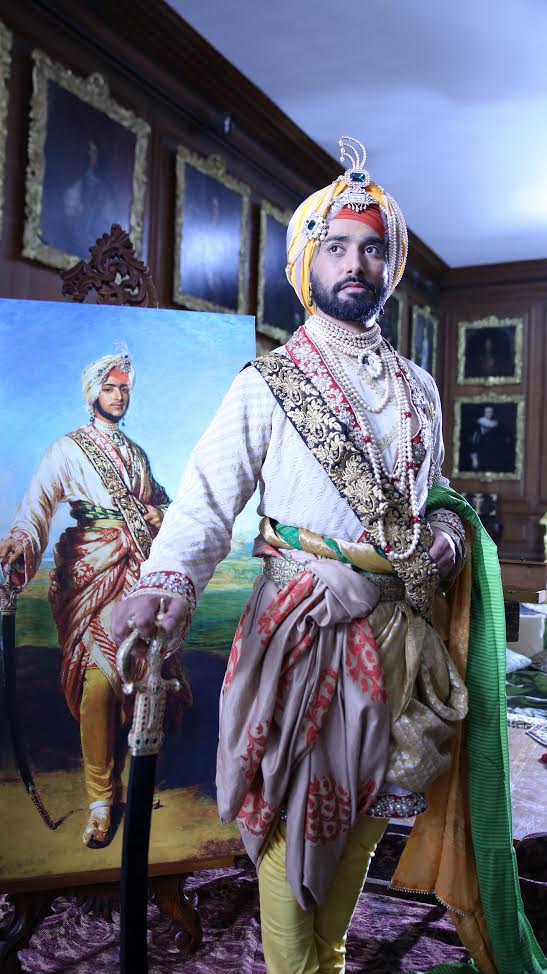The Black Prince Corrects Historical Distortions About Maharaja Ranjit Singh’s Family

How we live in the present is often a direct reflection of how we interpret the past—and it is also a very good indicator of how we will envision the future. But history never reveals the complete picture. It instead offers a representation of gathered information pieced together through the eyes of others who have curated the stories of those who came before us. Needless to say, the description of these personalities and events are commonly subject to inevitable human biases stemming from matters of upbringing, religion, culture or education.
Nobel prize winner V.S. Naipaul begins his discourse on Sikh history by citing an article from the Times of London claiming that the Sikhs burned a mutineer alive due to anger over the death of a British officer. Naipaul’s inclination to paint the Sikhs in a negative light is clear and his interpretation of the facts runs parallel to that of the colonial masters, who created this version of events prior to the partition of India. This particular “history” was subsequently adopted by those educated in the Machiavellian system.
As it happens, Maharaja Ranjit Singh was the last emperor king on the Indian subcontinent, the British declined to challenge during his reign. But upon his death, they began to execute their master plan to subjugate Ranjit’s empire under the British Raj through every method at their disposal. The Khalsa forces fought two great battles against the British before eventually succumbing as a result of internal turmoil and deceit. Yet Ranjit Singh was the first victim of Naipaul’s slanted pen.
It is important to note that Maharaja Ranjit Singh managed to reverse two millenniums of invasions from the North into India. He then set out to devise a master plan of historic proportions in which he sought to unite the whole country in a single masterful stroke to banish the British empire from Indian soil forever. Unfortunately, the British caught wind of his plan and crushed it before it could be realised.
Ranjit Singh was the first leader to plan and coordinate with other princely states. It would be another two decades before the Indian Mutiny of 1857, a scheme very similar to Ranjit Singh’s that also failed miserably due to disunity among the princes. Unfortunately, Naipaul’s narrative that the Sikhs were in some way responsible for the failed attempt in 1857 once again bears the fingerprints of the colonial thought process.
Interestingly, even the sage Swami Vivek Anand follows a very similar thread, calling Ranjit’s reign the darkest period of Indian history. There is no lack of irony in this point of view. Under Ranjit’s rule, there was complete religious harmony, literacy and economic prosperity for all, and he was also responsible for the abolishment of capital punishment. This can hardly be said of today’s democratic India.
Many leaders of the Indian Freedom movement also adhered to Naipaul’s perspective about the Sikhs. When it came to the tenth master, they pulled out all the stops to present him as a misguided prophet when in fact, he was not only a great patriot but also a great unifier.
All of this cannot be explained as a mere difference of opinion among historical writers but instead, it serves to illustrate the frustrating limitations placed upon many third world countries. Although politically free, their freedom is still a product of the colonial worldview, which itself is an outgrowth of centuries of indoctrination among the masses. This view continues to be pushed through the curriculums in schools, universities and PhD research programs. The British chose Ranjit Singh as their prime target precisely because he was a strong and unifying leader—a leader who could devise and execute a plan to its successful conclusion. The Mughals, Afghans and British all viewed him as a threat to their interests.

One would be hard pressed to find another person who was so intentionally targeted among within the world of academia. So why target Ranjit Singh? When one reviews this question closely, the answer is fairly simple. Although the British controlled over 500 of the princely states of India, they regarded him with simultaneous levels of fear, contempt and respect; they knew if there was a single obstacle to the British Empire in India, it was Ranjit Singh.
While some 500 princes roamed free and fraternized with their colonial masters, Ranjit’s own son Duleep was separated from his mother, Maharani Jind Kaur (who was herself imprisoned), converted to Christianity and exiled to England under the guardianship of Dr. John Login, where he became isolated among the English—never again to set foot in Punjab. The British had now removed every conceivable impediment so that Britain could rule over India for centuries to come.
One need not forget that British colonial imperialism compromised many thriving cultures with each acquisition, the results of which can be seen daily on Middle Eastern television or in the streets of Kashmir. The Indian subcontinent holds many untold stories of unimaginable bravery by local and regional forces. It remains unfortunate that historians have sought to wipe clean the extraordinary contributions of these unsung heroes against the might of the British Empire.
The final victory for the British was ultimately muted by the loss of 4000 of their soldiers against the forces of Sarker E Khalsa—a far greater number of casualties than they had endured in capturing the rest of India over a century of occupation.
Duleep and Maharani Jindan’s story begins with the fall of Ranjit Singh’s powerful empire. Over the course of her own imprisonment by the British, she makes three successive attempts to escape, dressed as a slave girl and navigating some 500 hundred kilometers through unfamiliar lands and nearly impossible terrain—finally reaching Nepal where she seeks and is granted asylum. With failing eyesight and poor health, she continues to focus on the idea of rebuilding her late husband’s kingdom. All the while, Duleep is being turned into a show piece for the Raj, becoming a lord and gentleman in England, completely unaware of his heritage and the great empire that was once his.
When Maharani Jindan finally meets Duleep she instead finds a stranger, now devoid of his own language, culture, religion, and legacy. Brick by brick, Maharani Jindan begins to rebuild her son, describing everything about the shining empire he has inherited and the great Khalsa Panth. She urges him to return back to the fold of Sikhism, to take Amrit, to become a Khalsa and fight for the kingdom that was taken from him in order to become its rightful leader.

The Black Prince, which was written and directed by the Hollywood-based Kavi Raz, produced by Brillstein Entertainment Partners and stars veteran Bollywood actress Shabana Azmi as Maharani Jind Kaur and the Punjabi singer-songwriter Satinder Sartaj as Duleep Singh, tells the tragic story of a mother and son. Beautifully crafted by these dedicated filmmakers, it walks the audience through Duleep’s struggle to regain his rightful place—and a very painful moment of India’s history.
Satinder Sartaaj’s portrayal of Duleep Singh is one of a highly sensitive man who, upon discovering his past, fully comes to realise his predicament and shortcomings, but also what lies at the heart of his own destiny. His inner turmoil is convincingly portrayed in every facial expression Sartaaj creates. Shabana Azmi adds Maharani Jindan to a growing list of brilliant portrayals. Azmi’s Jind Kaur is a mother who carries enormous pain in her heart for a son’s life she was never a part of, fused with anger about who he has become—but filled with hope for the man destiny wants him to be. When she finally meets Queen Victoria, Azmi subtly demonstrates her considerable skill by behaving not as a vanquished queen, but as an equal.
The Black Prince succeeds in bringing to life the pages of history that for years have been treated differently in academic circles across India. It attempts to set the record straight for all who see it.
